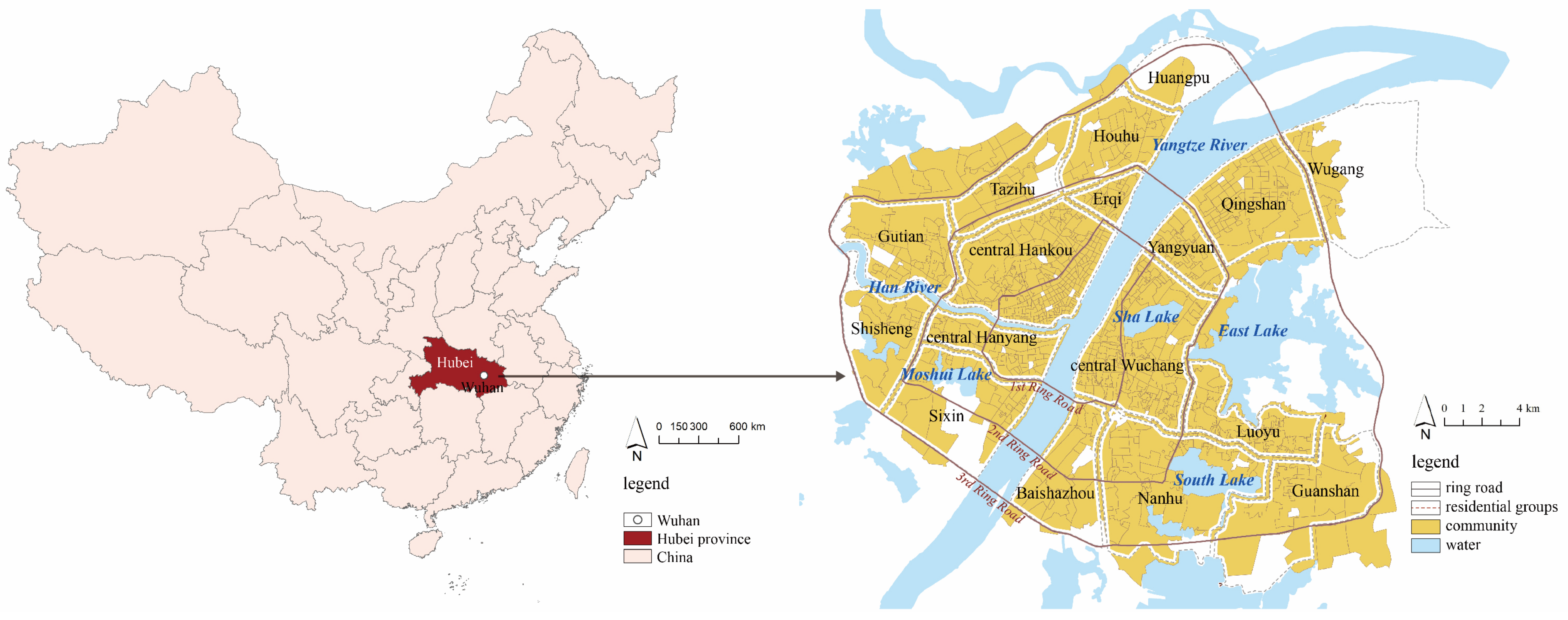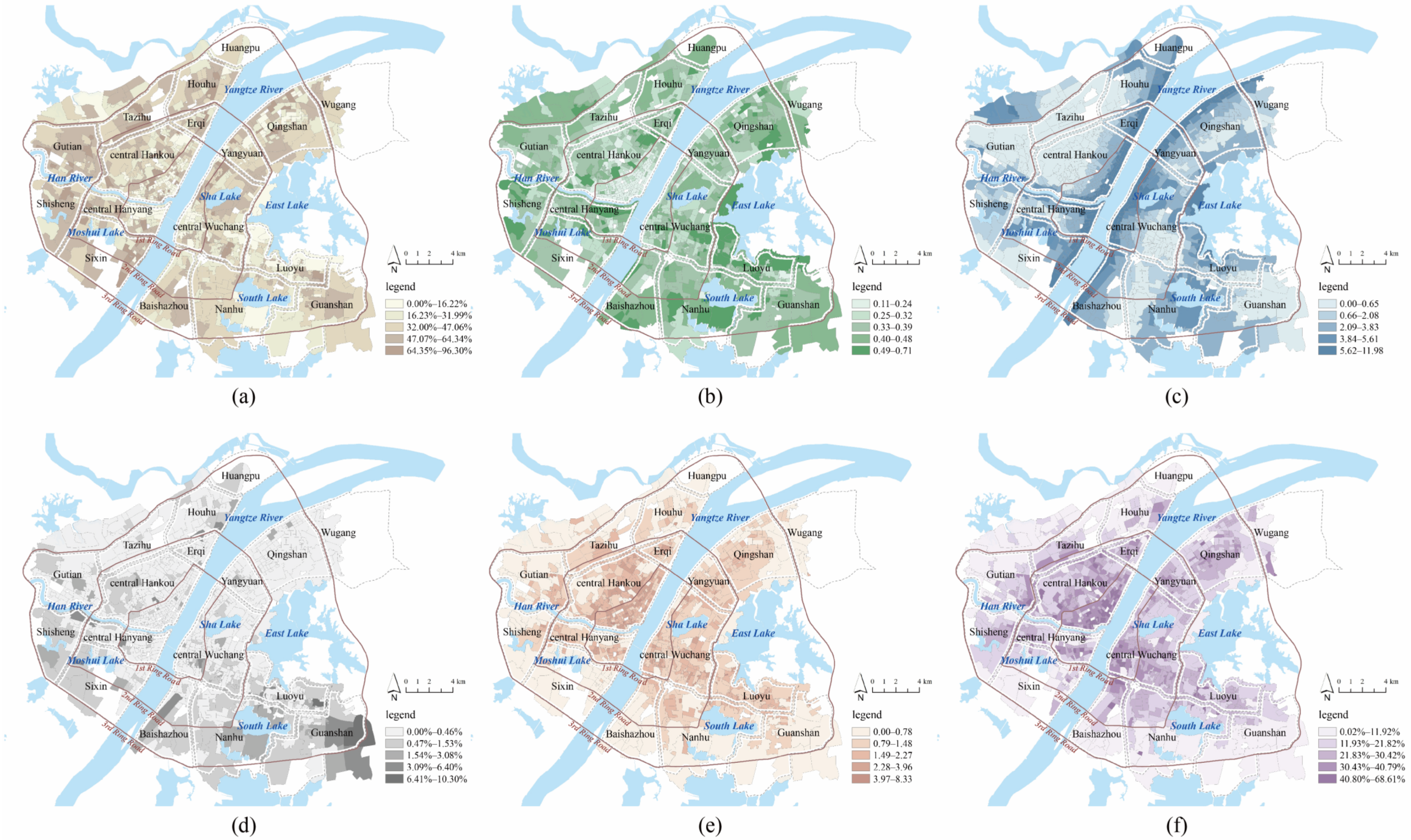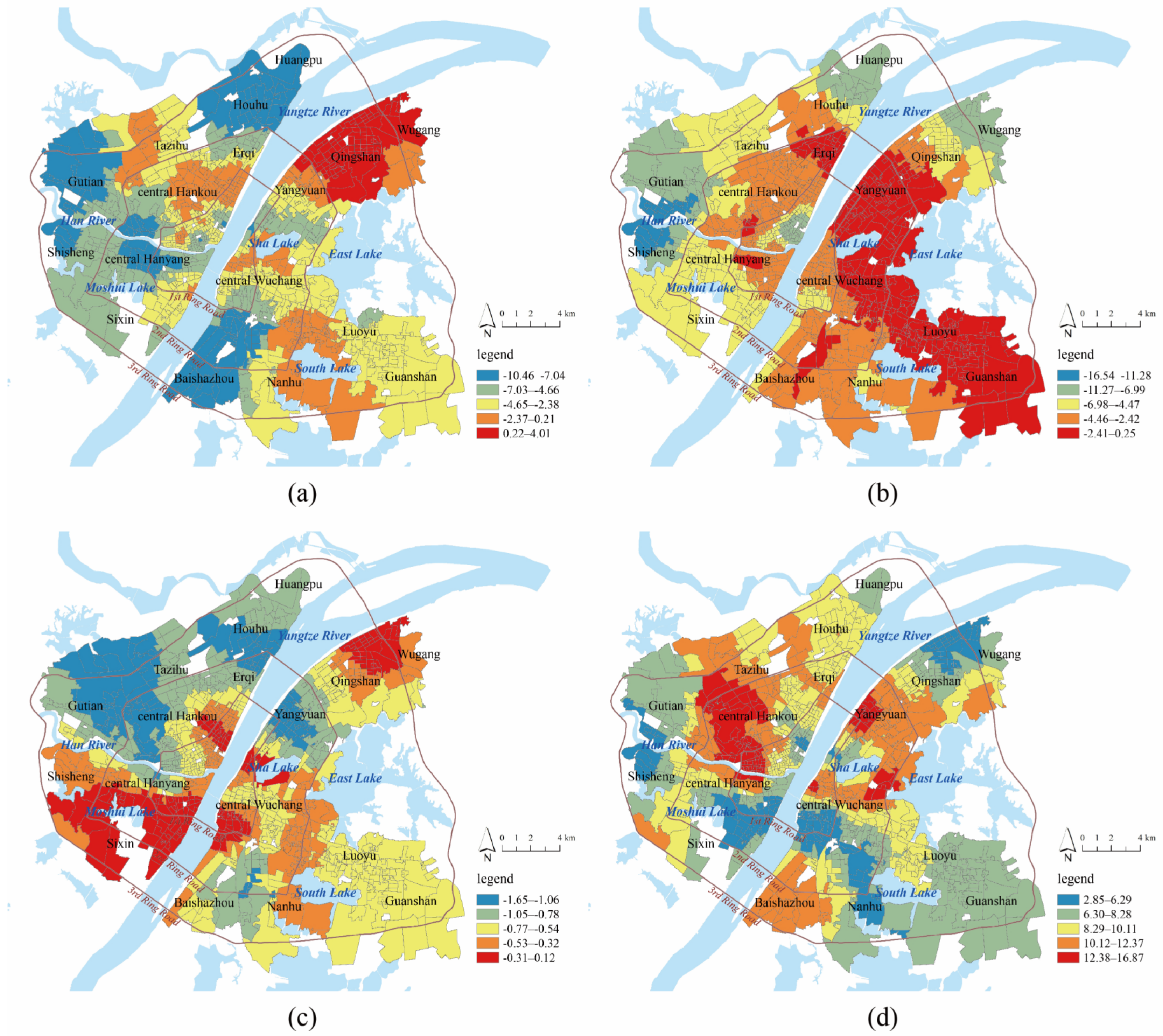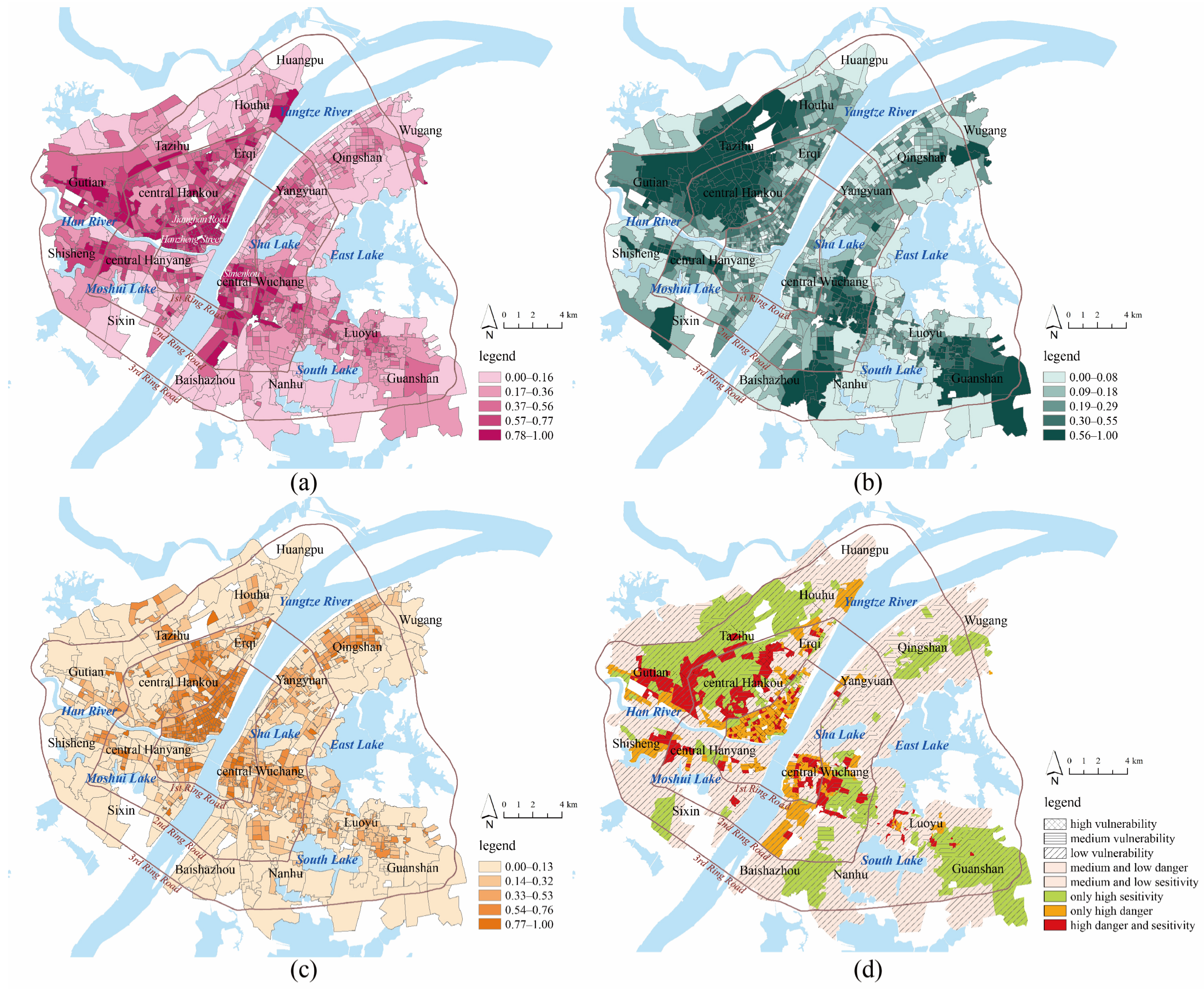High-Temperature Disaster Risk Assessment for Urban Communities: A Case Study in Wuhan, China
Abstract
:1. Introduction
2. Data and Methodology
2.1. Study Area and Data
2.2. Methodology
3. Results
3.1. Description of Temperature Distribution
3.2. Construction of Weight System
3.3. Assessment of Disaster Risk
3.3.1. Disaster-Causing Danger
3.3.2. Disaster-Generating Sensitivity
3.3.3. Disaster-Bearing Vulnerability
3.3.4. Comprehensive Risk
4. Policy Implications
5. Conclusions
Author Contributions
Funding
Institutional Review Board Statement
Informed Consent Statement
Data Availability Statement
Conflicts of Interest
References
- Xing, P.; Yang, R.; Du, W.; Dang, B.; Xuan, C.; Xiong, F. Spatiotemporal Variation of High Temperature Day and Heat Wave in North China during 1961–2017. Sci. Geogr. Sin. 2020, 40, 1365–1376. [Google Scholar]
- Xuemei, Z.; Yi, W.; Xiaoying, W.; Xi, Q.; Xinhua, Q. Comparison of heat wave vulnerability between coastal and inland cities of Fujian Province in the past 20 years. Prog. Geogr. 2016, 35, 1197–1205. [Google Scholar]
- Adams, C.R. Impacts of Temperature Extremes. 2016. Available online: https://sciencepolicy.colorado.edu/socasp/weather1/adams.html (accessed on 10 December 2021).
- Basu, R.; Samet, J.M. Relation between elevated ambient temperature and mortality: A review of the epidemiologic evidence. Epidemiol. Rev. 2002, 24, 190–202. [Google Scholar] [CrossRef] [PubMed]
- Akbari, H.; Konopacki, S. Energy effects of heat-island reduction strategies in Toronto, Canada. Energy 2004, 29, 191–210. [Google Scholar] [CrossRef] [Green Version]
- Luber, G.; McGeehin, M. Climate Change and Extreme Heat Events. Am. J. Prev. Med. 2008, 35, 429–435. [Google Scholar] [CrossRef]
- Changnon, S.A.; Kunkel, K.E.; Reinke, B.C. Impacts and Responses to the 1995 Heat Wave: A Call to Action. Bull. Am. Meteorol. Soc. 1996, 77, 1497–1506. [Google Scholar] [CrossRef] [Green Version]
- Xue, Q.; Xie, M.; Guo, Q.; Wang, Y.; Wu, R.; Liu, Q. Research progress on urban heat wave vulnerability assessment: A geographical perspective. Prog. Geogr. 2020, 39, 685–694. [Google Scholar] [CrossRef]
- NewScientist. 2003. Available online: https://www.newscientist.com/article/dn4259-the-2003-european-heatwave-caused-35000-deaths/ (accessed on 10 December 2021).
- Chen, M.; Geng, F.; Ma, L.; Zhou, W.; Shi, H.; Ma, J. Analyses on the Heat Wave Events in Shanghai in Recent 138 Years. Plateau Meteorol. 2013, 32, 597–607. [Google Scholar]
- Shui, W.; Chen, Z.; Deng, J.; Li, Y.; Wang, Q.; Wang, W.; Chen, Y. Evaluation of urban high temperature vulnerability of coupling adaptability in Fuzhou, China. Acta Geogr. Sin. 2017, 72, 830–849. [Google Scholar]
- Liu, X.; Tang, Q.; Yin, Y.; Xu, X. Regionalization of Integrated Environmental Risk of China under Future Climate Change. Sci. Geogr. Sin. 2018, 38, 636–644. [Google Scholar]
- Tang, F.; Xu, H. The Relationship Between Urban Reconstruction and Urban Heat Island Effect Based on Remote Sensing Technology: Cangxia District of Fuzhou City, China. Sci. Geogr. Sin. 2011, 31, 1228–1234. [Google Scholar]
- Yang, X.; Li, Y. The impact of building density and building height heterogeneity on average urban albedo and street surface temperature. Build. Environ. 2015, 90, 146–156. [Google Scholar] [CrossRef]
- Cui, Y.; Yan, D.; Hong, T.; Ma, J. Temporal and spatial characteristics of the urban heat island in Beijing and the impact on building design and energy performance. Energy 2017, 130, 286–297. [Google Scholar] [CrossRef] [Green Version]
- Huang, X.; Wang, Y. Investigating the effects of 3D urban morphology on the surface urban heat island effect in urban functional zones by using high-resolution remote sensing data: A case study of Wuhan, Central China. ISPRS J. Photogramm. Remote Sens. 2019, 152, 119–131. [Google Scholar] [CrossRef]
- Zhan, Q.; Meng, F.; Xiao, Y. Exploring the relationships of between land surface temperature, ground coverage ratio and building volume density in an urbanized environment. Int. Arch. Photogramm. Remote Sens. Spat. Inf. Sci. 2015, 40, 255. [Google Scholar] [CrossRef] [Green Version]
- Guo, G.; Zhou, X.; Wu, Z.; Xiao, R.; Chen, Y. Characterizing the impact of urban morphology heterogeneity on land surface temperature in Guangzhou, China. Environ. Model. Softw. 2016, 84, 427–439. [Google Scholar] [CrossRef]
- Weng, Q.; Liu, H.; Lu, D. Assessing the effects of land use and land cover patterns on thermal conditions using landscape metrics in city of Indianapolis, United States. Urban Ecosyst. 2007, 10, 203–219. [Google Scholar] [CrossRef]
- Yuan, M.; Yan, M.; Shan, Z. Is Compact Urban Form Good for Air Quality? A Case Study from China Based on Hourly Smartphone Data. Land 2021, 10, 504. [Google Scholar] [CrossRef]
- Aubrecht, C.; Ozceylan, D. Identification of heat risk patterns in the U.S. National Capital Region by integrating heat stress and related vulnerability. Environ. Int. 2013, 56, 65–77. [Google Scholar] [CrossRef]
- Reid, C.E.; O’Neill, M.S.; Gronlund, C.J.; Brines, S.J.; Brown, D.G.; Diez-Roux, A.V.; Schwartz, J. Mapping Community Determinants of Heat Vulnerability. Environ. Health Perspect. 2009, 117, 1730–1736. [Google Scholar] [CrossRef]
- Ying, X.; Fang, Z. Thermal environment effects of urban human settlements and influencing factors based on multi-source data: A case study of Changsha city. Acta Geogr. Sin. 2020, 75, 2443–2458. [Google Scholar]
- Zhu, Q.; Liu, T.; Lin, H.; Xiao, J.; Luo, Y.; Zeng, W.; Zeng, S.; Wei, Y.; Chu, C.; Baum, S.; et al. The spatial distribution of health vulnerability to heat waves in Guangdong Province, China. Glob. Health Act. 2014, 7, 25051. [Google Scholar] [CrossRef] [Green Version]
- Xie, P.; Wang, Y.; Peng, J.; Liu, Y. Health related urban heat wave vulnerability assessment: Research progress and framework. Prog. Geogr. 2015, 34, 165–174. [Google Scholar]
- Xue, M.; Wang, C.; Zhao, J.; Li, M. Spatial Differentiation Pattern and Influencing Factors of Tourism Economy in the Yellow River Basin. Econ. Geogr. 2020, 40, 19–27. [Google Scholar]
- Sun, C.; Ma, Q.; Zhao, L. Analysis of driving mechanism based on a GWR model of green efficiency of water resources in China. Acta Geogr. Sin. 2020, 75, 1022–1035. [Google Scholar]
- Pang, R.; Teng, F.; Wei, Y. A GWR-Based Study on Dynamic Mechanism of Population Urbanization in Jilin Province. Sci. Geogr. Sin. 2014, 34, 1210–1217. [Google Scholar]
- Ma, J. Risk Zonation of High Temperature Disaster in Luoyang Based on GIS. Meteorol. Environ. Sci. 2012, 35, 62–68. [Google Scholar]
- Si, M.; Zhao, G.; Li, C. Research on approaches to the improvement of community planning and Governance system in Shenzhen. City Plan. Rev. 2020, 44, 91–101,109. [Google Scholar]
- Lan, W.; Yinghui, J.; Xiaoling, Z.; Xinzhe, W.; Jijun, L.; Hao, G. Integrating Health in Territorial Spatial Master Planning: Methodology and Practice. Urban Plan. Forum 2021, 81–87. [Google Scholar]
- Xie, C.; Huang, B.; Liu, X.; Zhou, T.; Wang, Y. Population exposure to heatwaves in Shenzhen based on mobile phone location data. Prog. Geogr. 2020, 39, 231–242. [Google Scholar] [CrossRef]
- Harlan, S.L.; Brazel, A.J.; Prashad, L.; Stefanov, W.L.; Larsen, L. Neighborhood microclimates and vulnerability to heat stress. Soc. Sci. Med. 2006, 63, 2847–2863. [Google Scholar] [CrossRef] [PubMed]
- Shan, Z.; Wu, Z.; Yuan, M. Exploring the Influence Mechanism of Attractiveness on Wuhan’s Urban Commercial Centers by Modifying the Classic Retail Model. ISPRS Int. J. Geo-Inf. 2021, 10, 652. [Google Scholar] [CrossRef]
- Sobrino, J.A.; Jiménez-Muñoz, J.C.; Paolini, L. Land surface temperature retrieval from LANDSAT TM 5. Remote Sens. Environ. 2004, 90, 434–440. [Google Scholar] [CrossRef]
- Liu, W.Y.; Gong, A.D.; Zhou, J.; Zhan, W.F. Investigation on Relationships between Urban Building Materials and Land Surface Temperature through a Multi-resource Remote Sensing Approach. Remote Sens. Inf. 2011, 4, 46–53,110. [Google Scholar]
- Yuan, M.; Song, Y.; Huang, Y.; Hong, S.; Huang, L. Exploring the Association between Urban Form and Air Quality in China. J. Plan. Educ. Res. 2018, 38, 413–426. [Google Scholar] [CrossRef]
- Yuan, M.; Huang, Y.; Shen, H.; Li, T. Effects of urban form on haze pollution in China: Spatial regression analysis based on PM2.5 remote sensing data. Appl. Geogr. 2018, 98, 215–223. [Google Scholar] [CrossRef]
- Saaroni, H.; Ziv, B. The impact of a small lake on heat stress in a Mediterranean urban park: The case of Tel Aviv, Israel. Int. J. Biometeorol. 2003, 47, 156–165. [Google Scholar] [CrossRef]
- O’Brien Robert, M. A caution regarding rules of thumb for variance inflation factors. Qual. Quant. 2007, 41, 673–690. [Google Scholar] [CrossRef]
- De Jong, P.; Sprenger, C.; Van Veen, F. On Extreme Values of Moran’s I and Geary’s c. Geogr. Anal. 1984, 16, 17–24. [Google Scholar] [CrossRef]
- Zhang, X.; Shen, J.; Gao, X. Towards a comprehensive understanding of intercity cooperation in China’s city-regionalization: A comparative study of Shenzhen-Hong Kong and Guangzhou-Foshan city groups. Land Use Policy 2021, 103, 105339. [Google Scholar] [CrossRef]
- Zhang, X.; Cheung DM, W.; Sun, Y.; Tan, J. Political decentralization and the path-dependent characteristics of the state authoritarianism: An integrated conceptual framework to understand China’s territorial fragmentation. Eurasian Geogr. Econ. 2019, 60, 548–581. [Google Scholar] [CrossRef]
- Norton, B.A.; Coutts, A.M.; Livesley, S.J.; Harris, R.J.; Hunter, A.M.; Williams, N.S. Planning for cooler cities: A framework to prioritise green infrastructure to mitigate high temperatures in urban landscapes. Landsc. Urban Plan. 2015, 134, 127–138. [Google Scholar] [CrossRef]
- Tzoulas, K.; Korpela, K.; Venn, S.; Yli-Pelkonen, V.; Kaźmierczak, A.; Niemela, J.; James, P. Promoting ecosystem and human health in urban areas using Green Infrastructure: A literature review. Landsc. Urban Plan. 2007, 81, 167–178. [Google Scholar] [CrossRef] [Green Version]
- Johnson, D.P.; Stanforth, A.; Lulla, V.; Luber, G. Developing an applied extreme heat vulnerability index utilizing socioeconomic and environmental data. Appl. Geogr. 2012, 35, 23–31. [Google Scholar] [CrossRef]
- Bowler, D.E.; Buyung-Ali, L.; Knight, T.M.; Pullin, A.S. Urban greening to cool towns and cities: A systematic review of the empirical evidence. Landsc. Urban Plan. 2010, 97, 147–155. [Google Scholar] [CrossRef]
- Zhou, Y.; Tan, Z. Study on the mechanism of vertical conduction of spatial elements in german planning system: Based on the perspective of territorial and spatial planning. City Plan. Rev. 2020, 44, 68–77. [Google Scholar]
- The Renovation of Old Communities in Wuhan (2019–2021). Wuhan Housing Security and Management Bureau. Available online: http://fgj.wuhan.gov.cn/xxgk/xxgkml/ghjh/202006/t20200619_1381751.shtml (accessed on 10 December 2021).
- Li, Y.; Li, J.; Yan, H.; Shi, T.; Lu, N. ErrorAnalysis of building height Information extraction based on shadow length method. Sci. Surv. Mapp. 2016, 41, 44–49. [Google Scholar]





| Category | Metrics | Mean | Median | Min. | Max. |
|---|---|---|---|---|---|
| Land cover | Impervious land coverage | 37.64% | 37.50% | 0.00% | 96.30% |
| Normalized difference vegetation index | 0.34 | 0.34 | 0.11 | 0.71 | |
| Proximity to water | 2.80 | 2.75 | 0.00 | 11.98 | |
| Bare land coverage | 0.27% | 0.00% | 0.00% | 10.30% | |
| Development intensity | Floor area ratio | 1.46 | 1.38 | 0.00 | 8.33 |
| Building density | 25.49% | 25.58% | 0.02% | 68.61% |
| Factors | Standardized B Coefficient | Sig. | Tolerance | VIF |
|---|---|---|---|---|
| Impervious land coverage | −0.25 | 0.000 | 0.40 | 6.15 |
| Normalized difference vegetation index | −0.28 | 0.000 | 0.72 | 1.38 |
| Proximity to water | −0.30 | 0.000 | 0.79 | 1.25 |
| Bare land coverage | 0.033 | 0.061 | 0.91 | 1.11 |
| Floor area ratio | −0.25 | 0.000 | 0.45 | 2.18 |
| Building density | 0.54 | 0.000 | 0.40 | 2.47 |
| Metrics | Min. | Lower Quartile | Median | Upper Quartile | Max. | Mean | DIFF of Criterion | + (%) | − (%) |
|---|---|---|---|---|---|---|---|---|---|
| Normalized difference vegetation index | −10.46 | −5.82 | −3.67 | −2.12 | 4.01 | −3.66 | −47.29 | 9.66 | 90.34 |
| Proximity to water | −16.54 | −5.44 | −3.67 | −2.31 | 0.24 | −4.19 | −12.21 | 1.12 | 98.88 |
| Floor area ratio | −1.65 | −0.88 | −0.62 | −0.41 | 0.12 | −0.64 | −8.76 | 0.61 | 99.39 |
| Building density | 2.85 | 7.39 | 8.98 | 10.62 | 16.87 | 9.09 | −38.32 | 100 | 0 |
| Disaster-causing danger | Disaster-bearing vulnerability | |||||
| low | relatively low | medium | relatively high | high | ||
| low | 111 | 26 | 7 | 6 | 1 | |
| relatively low | 98 | 62 | 46 | 22 | 8 | |
| medium | 56 | 67 | 45 | 48 | 13 | |
| relatively high | 20 | 42 | 45 | 44 | 39 | |
| high | 19 | 22 | 27 | 40 | 59 | |
| Disaster-generating sensitivity | Disaster-bearing vulnerability | |||||
| low | relatively low | medium | relatively high | high | ||
| low | 99 | 26 | 23 | 18 | 18 | |
| relatively low | 67 | 64 | 39 | 54 | 28 | |
| medium | 48 | 44 | 43 | 35 | 33 | |
| relatively high | 26 | 39 | 24 | 30 | 25 | |
| high | 64 | 46 | 41 | 23 | 16 | |
| Disaster-causing danger | Disaster-generating sensitivity | |||||
| low | relatively low | medium | relatively high | high | ||
| low | 70 | 39 | 22 | 3 | 17 | |
| relatively low | 59 | 77 | 35 | 24 | 41 | |
| medium | 26 | 60 | 46 | 41 | 56 | |
| relatively high | 14 | 38 | 53 | 43 | 42 | |
| high | 15 | 38 | 47 | 33 | 34 | |
| Category | Priority Policy and Measures |
|---|---|
| Communities being built or to be built | Organize land use structure |
| Optimize architectural composition | |
| Old communities in the center of the city | Create vegetation space |
| Regulate building pattern | |
| Communities in urban villages | Create rainstorm landscape |
| Establish child-friendly facilities | |
| Establish elderly-oriented facilities | |
| Communities on the edge of the city | Increase greening layout |
| Improve infrastructure service |
Publisher’s Note: MDPI stays neutral with regard to jurisdictional claims in published maps and institutional affiliations. |
© 2021 by the authors. Licensee MDPI, Basel, Switzerland. This article is an open access article distributed under the terms and conditions of the Creative Commons Attribution (CC BY) license (https://creativecommons.org/licenses/by/4.0/).
Share and Cite
Shan, Z.; An, Y.; Xu, L.; Yuan, M. High-Temperature Disaster Risk Assessment for Urban Communities: A Case Study in Wuhan, China. Int. J. Environ. Res. Public Health 2022, 19, 183. https://doi.org/10.3390/ijerph19010183
Shan Z, An Y, Xu L, Yuan M. High-Temperature Disaster Risk Assessment for Urban Communities: A Case Study in Wuhan, China. International Journal of Environmental Research and Public Health. 2022; 19(1):183. https://doi.org/10.3390/ijerph19010183
Chicago/Turabian StyleShan, Zhuoran, Yuehui An, L’ei Xu, and Man Yuan. 2022. "High-Temperature Disaster Risk Assessment for Urban Communities: A Case Study in Wuhan, China" International Journal of Environmental Research and Public Health 19, no. 1: 183. https://doi.org/10.3390/ijerph19010183
APA StyleShan, Z., An, Y., Xu, L., & Yuan, M. (2022). High-Temperature Disaster Risk Assessment for Urban Communities: A Case Study in Wuhan, China. International Journal of Environmental Research and Public Health, 19(1), 183. https://doi.org/10.3390/ijerph19010183





